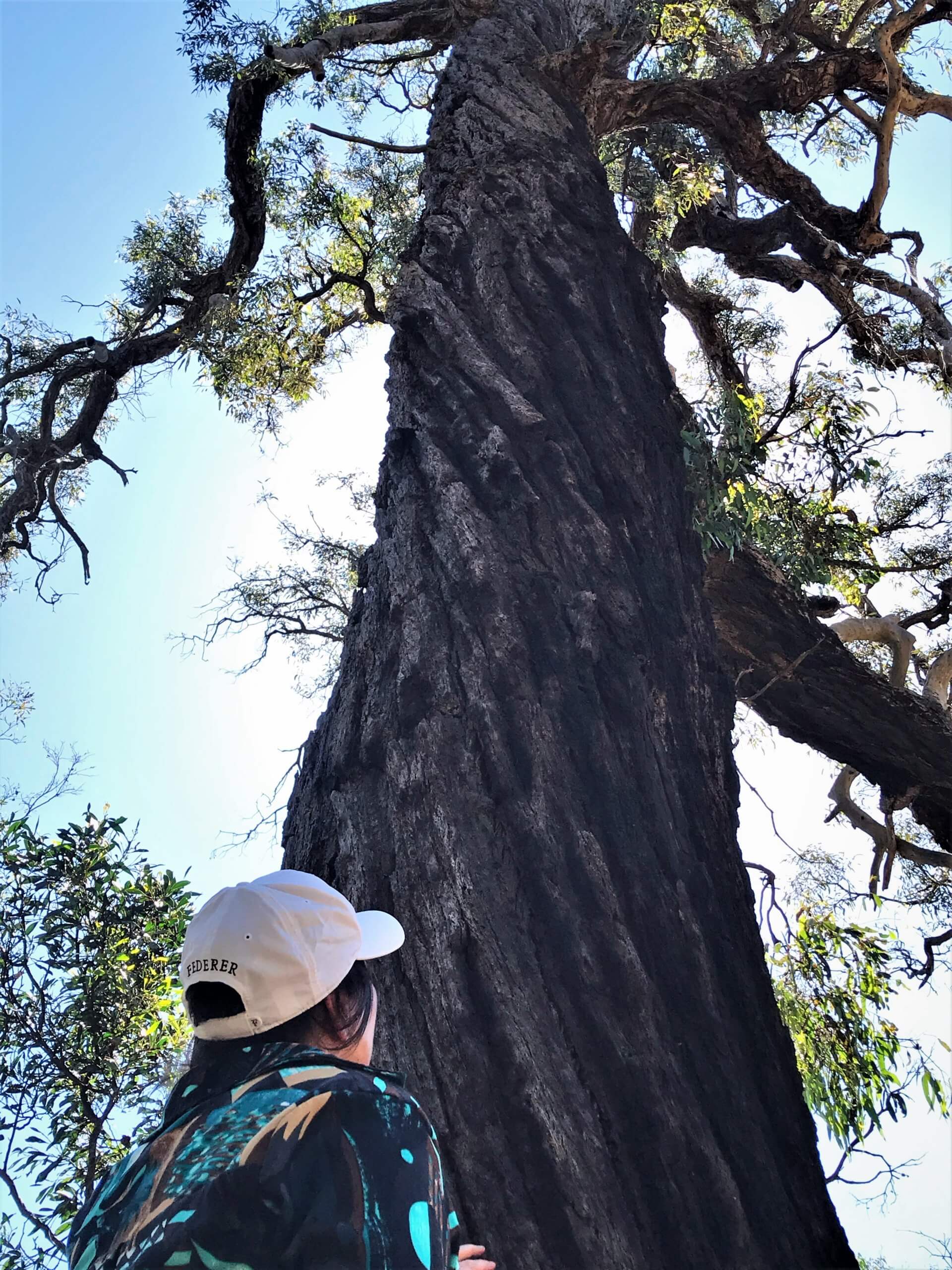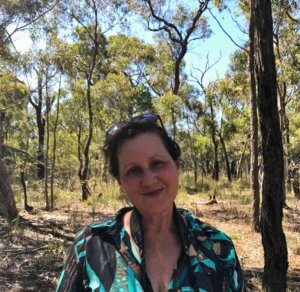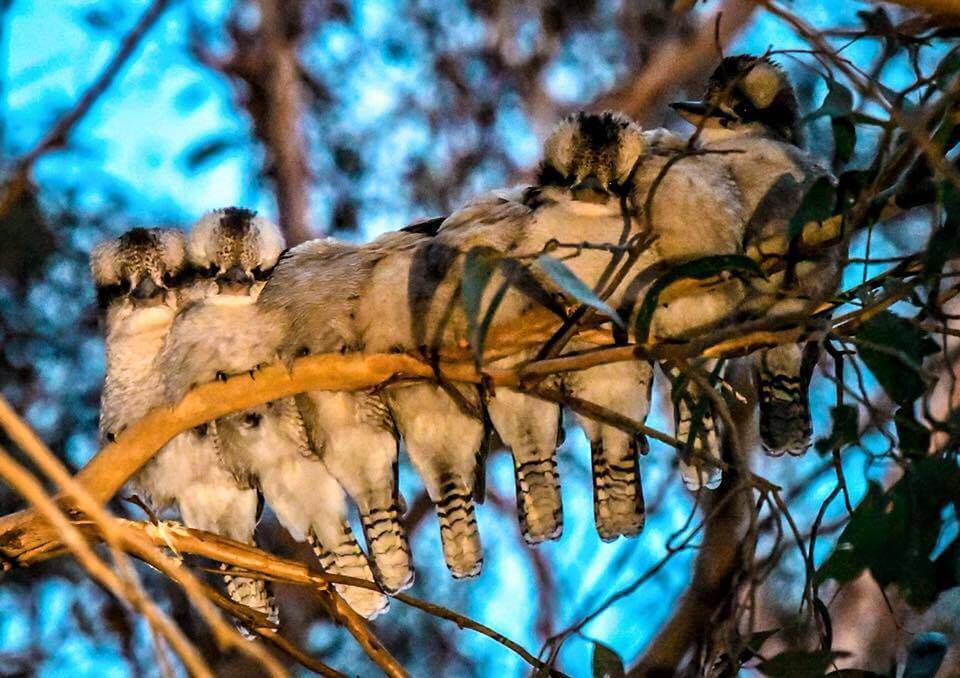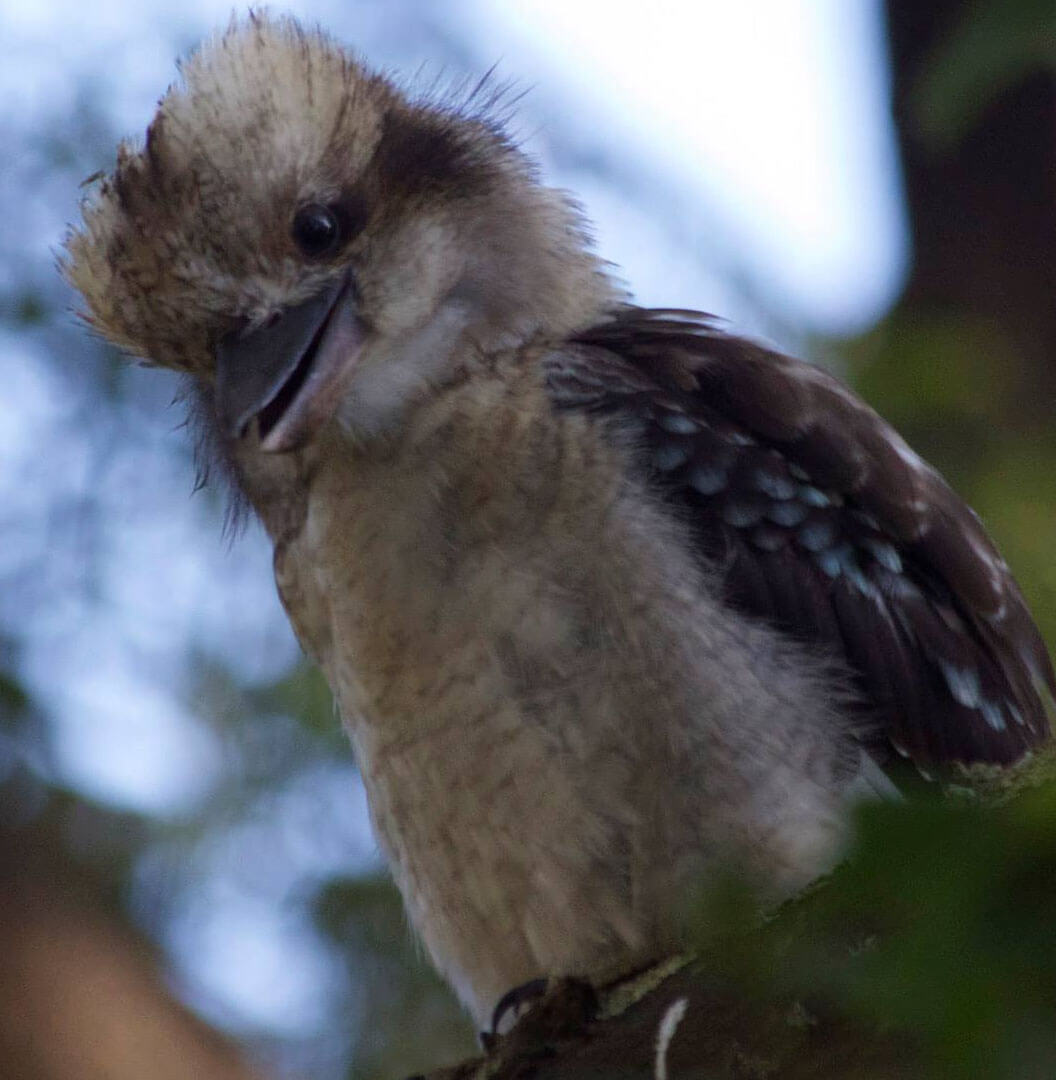A Story about a Bird and Fire
Unlike Other Birds, It Doesn’t Like the Dense New Growth Post Fire
By Diana Kuchinke
The swing-seat has a gun-metal grey, mild-steel A-frame, with polyester cushions. We didn’t plan for its home to be where it stands, it just ended up there because under the roof-line of the house, it is out of the weather. During the years I worked on my PhD data analysis and write-up, I often ended up on this seat. It was where I reflected, immersed in the thoughts that filled my head, trying to apply reasoned logic to reams of pages covered with data and graphs, and notes that sometimes made absolutely no sense whatsoever.
On this one particular day, I was drained of life. That was often the case by late afternoon. It was dusk. I was holding a vodka martini. That was also often the case. And I was trying to apply some biological reasoning to my thought patterns. The laughing kookaburra (Dacelo novaeguineae) was the only bird out of 56 species I had observed over two years from a total of 10,296 individuals that responded so unquestionably to fire. Not in the way you might expect. It didn’t disappear from patches of vegetation with ash-grey ground and dense epicormic growth sprouting from blackened tree-trunks. My data and models showed that its numbers dropped when flush new growth covered the ground, as is the case in heathy-dry forests from about 3-10 years post fire. And, it preferred vegetation unburnt since the extensive 1939 conflagrations that burnt across this region. The fact that it cannot see its prey in dense ground cover was obvious to me.
But, I wondered if there wasn’t something else pushing this bird out of the dense post-fire patches that most birds love. It was on the swing-seat, at that time of day when the birds are all feeding before the sun sets, that I spotted two carnivorous birds only metres apart – a laughing kookaburra and a grey currawong (Strepera versicolor). I sat still, watching.
What everyone knows about a laughing kookaburra is its distinctive call; a vocal pattern that starts as a low-tone, rolling chuckle. With no break in its music, the call rises up the scale, hitting a top note. It pierces the air. Chortles. A high-pitched laughing ‘koo koo koo koo kaa kaa kaa kaa’. For a non-Australian, they might think after that first chorus, the kookaburra has finished. But it starts again, rolling the notes, one after the other. Peals of laughter. The laughing kookaburra changes the tone of its music by opening and closing its beak – wide for the top notes, closing its beak slightly for the low. The bushman’s alarm clock. It is one of the most distinctive sounds of Australia – to fauna what the didgeridoo is to human music.
But if you watch, as well as listen, what you will notice about the laughing kookaburra is its pounce. From motionless to wings extended, as it descends to earth
at about 30km/hr, it snatches its prey. As I watched, a southern grass skink writhed in the kookaburra’s beak. The kookaburra bashed its meal against the ground. A 46cm-long bird with just a ten-centimetre beak and claws subdued the skink; killing it was necessary. The kookaburra flew back to its perch, ten metres above ground and gulped the skink. The first swallow and a skink tail was left hanging from its mouth. A second swallow, and the tail disappeared. The kookaburra sat motionless.

It was the second bird that I watched on that day that completed the tableau. The grey currawong is the kookaburra’s competitor for the same food source. Related to the Australian magpie, it is comparable in size to the kookaburra. In heathy-dry forests, both the laughing kookaburra and the grey currawong will co-inhabit a space. Assuming ample prey, the currawong spends seventy percent of its forage time at ground level and the remaining thirty percent high in the canopy, while the kookaburra pounces from height. I watched these two. The kookaburra sat high while the grey currawong walked across the dry ground directly below. No shrubs, little grass, the older heathy-dry forest has little ground cover.
Our property, in the middle of heathy-dry forest, had burnt in 2006, eleven years prior. But this habitat changes, especially from fire. Assuming a family of kookaburras flees fire in a heathy-dry forest and survives, they must be able to persist for six months in the territory of other laughing kookaburras, before they return. In a heathy-dry forest, vegetation regrowth post fire begins around six months; and most common birds have at that point, returned. But the kookaburra must again leave, perhaps in two years, as the new ground growth creates dense cover; unsuitable for a broad range of reptiles that they feed on, which require open-canopy environments for basking. Not only is the food source reduced, but the kookaburra must compete against the grey currawong for it. Burning more than once a decade in a heathy-dry forest can result in perpetual ground-cover vegetation. It’s all in the timing.
I checked my data. In heathy-dry forests, there is a 5-fold decrease in the occurrence of these two birds together in the dense new-growth vegetation, compared with vegetation that has had at least ten years to recover post-fire. For the kookaburras, it becomes a law of diminishing returns against them. The more the new growth develops and the denser it becomes, the less food is available for the bird that pounces from height. Meanwhile, land clearing continues unabated across the Australian landscape, removing the tree hollows essential for kookaburras to persist.
As I sat on the swing-seat, watching and thinking, my thoughts regressed, like a movie in rewind, spinning back through history and the phylogenetic tree of the ancestors of the kookaburra. One hundred and fifty years ago, a kookaburra sat, same location, different tree. A winter fog dropping dew on its feathers, as it ruffled them before making an early morning call. Back further to five hundred years ago, same location, different tree, this one a female, sitting next to her life-mate, out of the hollow for a sunrise feed before heading back into the nest to feed her chicks. Back and back, past the one-thousand year mark, past the five-thousand year mark, back past the 65,000 year mark, when man first walked across the Australian landscape, back to the laughing kookaburra’s most recent divergence from other Dacelo species, about two million years ago in the Pleistocene. The climate then ran through warm-wet to cold-dry phases, and in this area the stretches of sclerophyllous vegetation had expanded; trees with hard leaves and not much distance between leaves on a stem. Back even further, the film whirrs through a divergence of the kookaburra from relatives at the 3.5 million year mark in the Pliocence, when Australia first drifted north and the continent dried out, with a gap in time when pollen wasn’t preserved. But it was cooler, and drier, and sclerophyll vegetation had started to take hold. And we go back further still to the 9 million year mark, then the 13.8 million year mark, and still further back, to the first divergence representing colonisation of Halcyoninae in Australia from the kingfisher’s Alcedinidae family, about 16.3 million years ago, in the Miocene, where this location in space was at a higher latitude with a more polar-light environment. The kookaburra’s ancestor stood on the bough of a rainforest tree, wings still, eyes alert, cloaked by cloud and gentle rain; watching and waiting. A sentinal in an ancient landscape. Today, it is waiting still.. Today, it is waiting still.
Some months after my epiphany on the swing-seat, I took a walk down the road that extends from our property, north-south through the National Park. I stopped at an ironbark tree, standing majestically thirty metres tall in the sparse heathy-dry forest.
A heathy-dry forest is not a dense forest with numerous species at various heights filling the void from ground to canopy. It has a simpler structure: ground cover, tree trunks and canopy, a product of poor-quality soils. Surrounded by eleven-year-old stringy-bark and black wattle post-fire regrowth, this ironbark’s coat was vertically lined grey and black, trunk and boughs furrowed four to five centimetres deep, an accumulation of dead bark that over the years had created fissures and protected its core from fire. I could see that the coat faded to grey on the western side of the tree. Around the rest of its trunk, this tree bore the scars of the wildfires of 1939 and 2006 and the controlled burn of 1994, the tops of the furrows still black. I couldn’t tell which black scars related to which fire but anecdotally, I had heard that this tree was alive before the 1939 fires. At five metres above ground level, the trunk extended into its lowest level, half-metre thick, furrowed bough with gnarly branches; more than a dozen dead extensions winding outwards through the air, each not much more than a metre long. The last held light branches, new growth since 2006. It was winter and the thin branches hung heavy with one of the largest flowers in the eucalypt species.
I watched from a distance, standing quietly. On the bough sat a laughing kookaburra. Was it the same one that was near my house months earlier? It was likely.
The laughing kookaburra is highly territorial. They have clearly defined territorial boundaries, from about sixteen to 240 hectares, a size determined by resource availability – hollows and food – and by the flock size and their ability to defend space. But that territorial range is shrinking. A set of “synergistic wicked problems” – set in motion by the hands of humans/numerous, complex and including climate change – is impacting Australia’s iconic bird with dramatic effect. “The New Atlas of Australian Birds” published in 2003 listed the laughing kookaburra as being in abundance. “The State of the Birds Report” created by Birdlife Australia in 2015 lists it in major decline down the whole east coast of Australia.
The kookaburra is in trouble. It is easy to see why. Urban development down the entire east coast of Australia removes trees with hollows. Permits to control that are issued by State Government officers remove birds from their territories. Two Australian states consider the laughing kookaburra to be an exotic species and so offer no protection. And in recent years, fire frequency in the landscape has increased such that dense new growth, loved by most birds, proves a problem for the kookaburras that then can’t pounce to feed. They are competing for a food source, already limited, because basking prey reduces in dense cover. And there are fewer places for them to regroup. The land clearing strips away not only their traditional range but potential sanctuaries where they might recover and from which they might return. The laughing kookaburra sat, watching; an icon of the ages woven into the Australian landscape. But today, it is ruled by a sovereign hand that is determining its fate. Death by a thousand cuts.
I stood motionless. It must have seen me; it can see an earthworm from fifty metres. It sat quietly, no doubt scanning the open ground for basking lizards. I began to walk away. With the first crack of ground cover under my feet, the kookaburra flew off.
 Dr Diana Kuchinke is a fire ecologist. Her PhD in 2018 ‘Investigating bird responses to fire in the heathy dry forests of Victoria, Australia’ reviewed bird responses to wildfire and controlled burns in terms of time-since-fire, fire frequency and burn severity for individual species, foraging guilds and communities. She works as a sessional lecturer at Federation University in Ballarat. Diana lives with her family on a property enclosed within the Brisbane Ranges National Park, a heathy-dry temperate forest in Victoria. Her property burnt in a bushfire in 2005.
Dr Diana Kuchinke is a fire ecologist. Her PhD in 2018 ‘Investigating bird responses to fire in the heathy dry forests of Victoria, Australia’ reviewed bird responses to wildfire and controlled burns in terms of time-since-fire, fire frequency and burn severity for individual species, foraging guilds and communities. She works as a sessional lecturer at Federation University in Ballarat. Diana lives with her family on a property enclosed within the Brisbane Ranges National Park, a heathy-dry temperate forest in Victoria. Her property burnt in a bushfire in 2005.
This article is the product of the IAWF mentoring program in 2020; Diana was mentored by Stephen Pyne.


